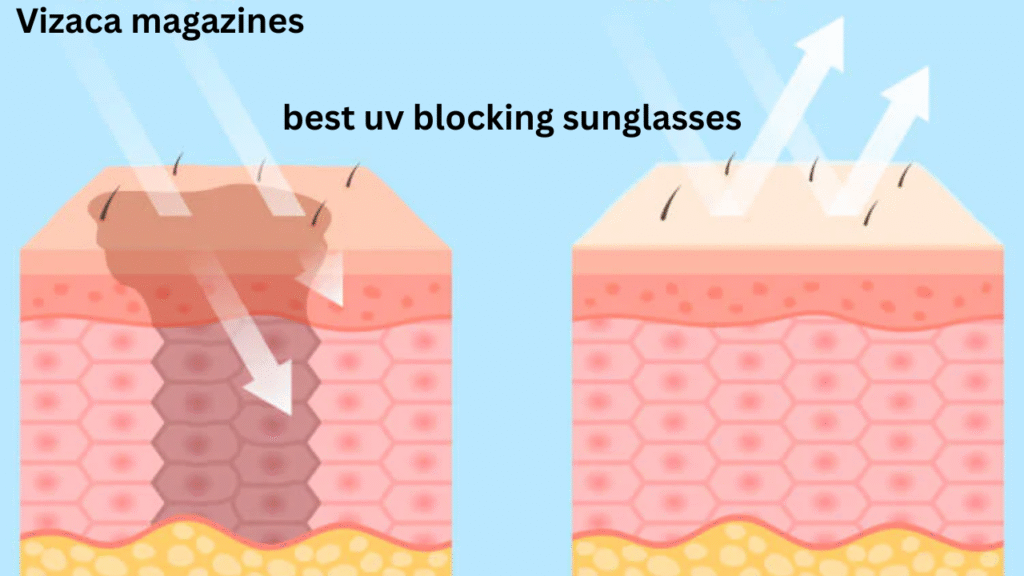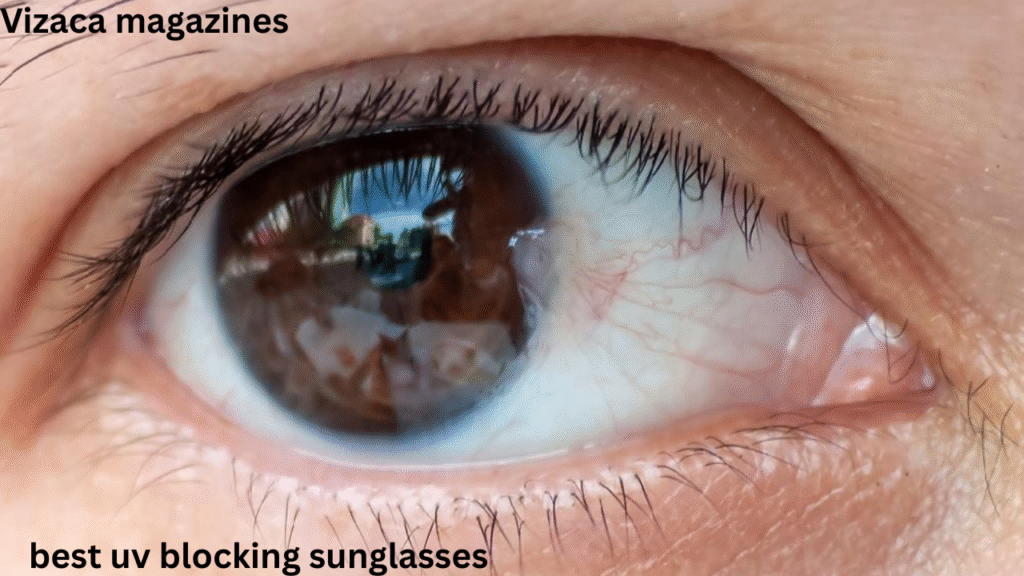The Best UV Blocking Sunglasses: A Complete Guide to Protecting Your Eyes from Harmful Rays
Sunlight is essential to life, but overexposure to ultraviolet (UV) radiation can severely damage your eyes. Just as you protect your skin with sunscreen, your eyes also require defense from harmful UV rays. Prolonged exposure without protection can lead to serious issues like cataracts, macular degeneration, and other vision disorders. The “best UV blocking sunglasses“ not only reduce glare and enhance visual clarity but also safeguard your eyes against invisible threats from the sun. This guide offers a complete breakdown of why UV protection is crucial, what makes certain sunglasses superior, and how to choose the right pair for your lifestyle.
Understanding UV Radiation: UVA and UVB Explained

To understand the importance of the best UV blocking sunglasses, you must first know what UV rays are. The sun emits different types of UV rays—UVA, UVB, and UVC. While UVC is absorbed by the earth’s atmosphere, UVA and UVB rays penetrate and can cause long-term damage.
- UVA rays penetrate deep into the eye and contribute to aging-related eye damage.
- UVB rays are responsible for more immediate damage like corneal sunburns (photokeratitis) and are closely linked to cataracts.
Wearing sunglasses that block both UVA and UVB rays is essential for maintaining lifelong eye health.
What Does “UV400” Mean and Why It’s Important

When shopping for the best UV blocking sunglasses, look for the label “UV400.” This rating ensures the lenses block all light rays with wavelengths up to 400 nanometers, covering both UVA and UVB rays entirely. UV400 is the industry standard for complete protection and is often used by optometrists and eye care professionals to determine safety levels.
Some lenses may appear dark but lack adequate UV protection. Without UV400 labeling, these sunglasses can dilate your pupils and allow more harmful light into your eyes—actually increasing the risk of damage.
How UV Exposure Affects Eye Health

Your eyes are vulnerable to sun exposure all year round. Snow reflects up to 80% of UV rays, while sand, water, and pavement can reflect between 10% to 25%. Prolonged UV exposure can lead to:
- Cataracts: Clouding of the eye’s lens.
- Macular Degeneration: A leading cause of age-related vision loss.
- Photokeratitis: A painful condition akin to sunburn but affecting the eye.
- Pterygium: A growth on the eye surface that can alter vision.
Wearing the best UV blocking sunglasses significantly lowers the risk of these issues by filtering harmful rays before they reach your eyes.
Certifications to Look For in UV Blocking Sunglasses
Choosing the best UV blocking sunglasses means checking for proper certifications. Regulatory bodies around the world have different standards to confirm UV protection.
- UV400 Certification: Guarantees full protection from UVA and UVB rays.
- ANSI Z80.3 (USA): Standard for non-prescription sunglasses ensuring impact resistance and UV protection.
- ISO 12312-1 (Europe): Ensures that sunglasses block a significant portion of UV rays, although it may not include full UV400 protection.
- CE Marking: Common in Europe, but you should still verify if it includes UV400 protection.
Avoid sunglasses that do not list their UV protection levels, as appearance can be deceptive.
Key Features of the Best UV Blocking Sunglasses
When evaluating the best UV blocking sunglasses, don’t focus solely on price or fashion. Consider these functional features:
Lens Material
- Polycarbonate: Lightweight and impact-resistant.
- Glass: Superior clarity but heavier and breakable.
- Nylon: Durable and often used in performance sunglasses.
Lens Coatings
- Anti-reflective Coating: Reduces glare from light hitting the back of the lenses.
- Scratch-Resistant Coating: Enhances durability.
- Mirror Coating: Reflects light and reduces the amount entering the eyes.
Polarization
Polarized lenses are not the same as UV-protective ones. However, many high-quality sunglasses include both. Polarization cuts glare, especially helpful when driving or near water surfaces.
Wraparound Design
Frames that wrap around your face offer more protection by blocking light from the sides.
Market Trends: UV Sunglasses Are on the Rise
The global demand for the best UV blocking sunglasses is rapidly increasing. As awareness about eye health grows, more people are investing in quality eyewear. In 2023, the global UV-protection sunglasses market was valued at around $6 billion and is expected to grow significantly, potentially reaching $57 billion by 2033.
People are becoming more conscious not just about fashion, but also the protective benefits sunglasses can offer. Advanced technologies like photochromic lenses (which adjust to light conditions) and blue-light filters are now common in high-end models.
Top Brands Known for the Best UV Blocking Sunglasses
Let’s explore the leading brands that consistently deliver on protection, performance, and style.
Maui Jim
Renowned for its PolarizedPlus2 technology, Maui Jim sunglasses block 100% of UVA and UVB rays. They offer exceptional clarity, color enhancement, and lens durability. Best for beachgoers and outdoor adventurers.
Oakley
Originally designed for athletes, Oakley sunglasses meet ANSI standards for both impact resistance and UV protection. Many of their lenses are polarized and ideal for sports use.
Ray-Ban
A classic name in eyewear, Ray-Ban offers stylish options that don’t compromise on UV protection. Most of their lenses are UV400-rated and available in various iconic styles.
Costa Del Mar
Popular among anglers and outdoor enthusiasts, Costa’s lenses offer full UV protection and are all polarized. They’re also a pioneer in using eco-friendly materials for frames.
Sojos
A newer brand, Sojos combines affordability with UV400 protection. Great for fashion-forward buyers looking for budget-friendly options without sacrificing safety.
Choosing the Right Pair for Your Lifestyle
To get the most benefit from the best UV blocking sunglasses, match the features with your daily activities:
- Driving: Look for polarized lenses with anti-glare coating.
- Sports & Outdoors: Go for lightweight, impact-resistant polycarbonate lenses with a wraparound design.
- Casual/Fashion: Style-conscious buyers can choose fashionable frames with confirmed UV400 protection.
- Fishing or Water Sports: Polarized lenses are a must to cut through water glare and ensure eye comfort.
Myths and Misconceptions About UV Sunglasses
Many people assume that darker lenses automatically provide better UV protection. This is a myth. Lens darkness does not equate to UV filtration. In fact, dark lenses without UV protection can be more harmful than no sunglasses at all because they encourage pupil dilation.
Another misconception is that all expensive sunglasses are safer. While many premium brands offer excellent UV protection, always verify the UV rating regardless of price.
How to Test Your Sunglasses for UV Protection
While most consumers rely on labels, testing is the best way to confirm your eyewear’s safety. Optical shops can test your lenses using UV meters. You can also purchase a UV flashlight and a UV-detecting card to test them at home, although this method is less reliable.
If your sunglasses are not labeled UV400 or “100% UV protection,” it’s safer not to use them as your primary defense against the sun.
Eco-Friendly Options in UV Sunglasses
Sustainability is also gaining momentum in the eyewear industry. Brands like Costa Del Mar and others are offering biodegradable frames, recycled materials, and low-impact manufacturing processes—all while delivering full UV protection. If you’re environmentally conscious, choosing sustainable models allows you to protect your eyes and the planet simultaneously.
Final Thoughts: Don’t Compromise When It Comes to Eye Health
In a world where vision is everything, wearing the best UV blocking sunglasses is one of the easiest and most effective ways to protect your long-term eye health. From UV400-certified lenses to polarized coatings and sustainable materials, the options today are better and more diverse than ever.
Whether you’re lounging on a beach, driving to work, or hiking a trail, your eyes need protection just as much as your skin. Make UV protection a daily habit—not just a fashion statement. The health of your eyes depends on it.
FAQs
1. What does UV400 mean on sunglasses?
UV400 means the lenses block all light rays with wavelengths up to 400 nanometers, covering both UVA and UVB rays. It’s the highest level of protection available in sunglasses.
2. Are polarized sunglasses also UV blocking?
Not always. Polarization reduces glare but doesn’t guarantee UV protection. The best UV blocking sunglasses often include both polarized lenses and UV400 certification.
3. How can I tell if my sunglasses have UV protection?
Check the label for “UV400” or “100% UV protection.” You can also get them tested at an optical shop using a UV meter.
4. Can cheap sunglasses offer the same UV protection as expensive ones?
Yes, if they are UV400-certified. Price doesn’t always determine protection, but certification does.
5. Why is UV protection in sunglasses so important?
Prolonged UV exposure can lead to serious eye conditions such as cataracts, macular degeneration, and photokeratitis. Wearing the best UV blocking sunglasses helps prevent these risks and maintains eye health over time.
Read More: Exploring the Categories on Shopnaclo: Beyond the Standard Shopping Experience??





